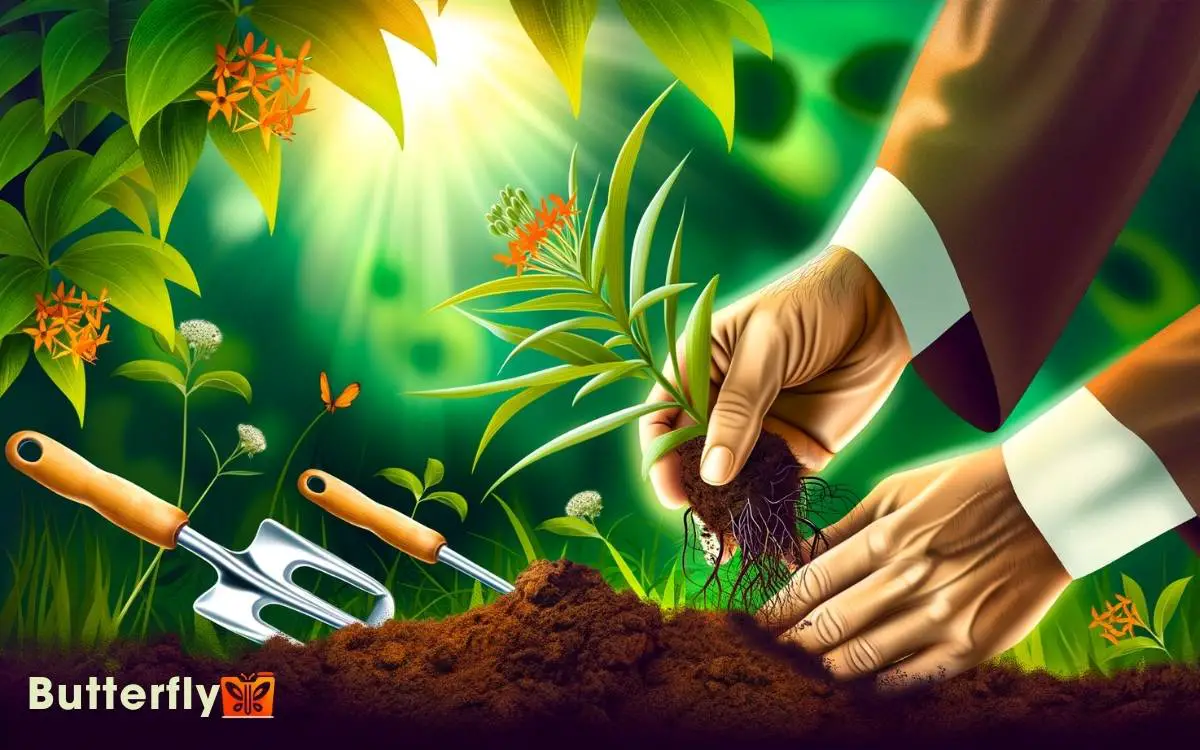How To Plant Butterfly Weed Bare Root? Comprehensive Guide!
To plant butterfly weed bare root, start by choosing a sunny site with good drainage and well-drained, sandy or loamy soil.
Loosen the soil to 12 inches deep and amend it with organic matter. Place the bare root with the crown just below the soil surface and spread the roots naturally.
Fill the hole with soil, firming it to remove air pockets. Water deeply once a week and mulch with a 2-3 inch organic layer, keeping mulch away from the stem.
Regularly prune, monitor for pests, and apply slow-release fertilizer in early spring for best results. Discover the full care routine next.

Key Takeaways
Selecting the Perfect Site
Selecting the appropriate site for planting Butterfly Weed is crucial to achieve the best growth and blooming. You should choose a location that receives full sun, as Butterfly Weed thrives in bright, direct light.
Make sure the site has good drainage; standing water can damage the roots and hinder growth. Consider the surrounding environment Butterfly Weed can tolerate a range of soil types but prefers sandy or loamy textures.
Avoid areas prone to competition from other aggressive plants, as they may overshadow or compete for resources. Additionally, select a location that offers some wind protection to prevent physical damage to the plant.
Preparing the Soil
To prepare the soil for planting Butterfly Weed, start by loosening it to a depth of about 12 inches to guarantee proper root establishment. This step guarantees the roots can penetrate easily and access nutrients. Remove any weeds or debris to create a clean planting area and mix in organic compost to improve soil fertility. When learning how to plant butterfly milkweed, choose a sunny location with well-draining soil to support healthy growth. Water the soil lightly after planting to help the roots settle in place.
Next, test the soil pH to make sure it falls between 6.0 and 7.0. Amend the soil with organic matter such as compost or aged manure to improve drainage and fertility.
Here’s a quick guide:
| Step | Action | Purpose |
|---|---|---|
| Loosening | Dig to 12 inches | Root establishment |
| Testing | Check soil pH | Optimal pH 6.0-7.0 |
| Amending | Add organic matter | Enhance drainage & nutrients |
Planting the Bare Root
After preparing the soil, position the bare root Butterfly Weed so the crown sits just below the soil surface. Make sure the roots are spread naturally in the planting hole to promote healthy growth.
Use your hands to fill the hole with soil, gently firming it around the root to eliminate air pockets.
- Check depth: Confirm the crown remains just below the soil surface.
- Spacing: Maintain a distance of 18-24 inches between plants to allow for proper airflow and growth.
- Soil contact: Ensure the roots have direct contact with the soil for best nutrient uptake.
This method ensures your Butterfly Weed establishes a robust root system. Proper root placement and spacing are crucial for fostering a thriving, innovative garden.
Watering and Mulching
Water your newly planted Butterfly Weed thoroughly to help settle the soil around the roots and eliminate any remaining air pockets.
Consistent moisture is vital, so water deeply once a week. Mulching is essential for retaining soil moisture and regulating temperature.
| Task | Description |
|---|---|
| Watering | Water deeply once a week to guarantee consistent moisture. |
| Mulching Depth | Apply a 2-3 inch layer of organic mulch around the plant. |
| Mulch Type | Use organic mulch like wood chips, straw, or shredded bark. |
| Avoid Mulch Pile | Keep mulch a few inches away from the stem to prevent rot. |
Ensure the mulch layer is evenly spread, and avoid piling it against the plant stem. This innovative approach promotes healthier, more robust growth.
Ongoing Care and Maintenance
Regular pruning and monitoring for pests and diseases are crucial for maintaining the health and vigor of your Butterfly Weed. You’ll want to prune dead or damaged stems in early spring to encourage new growth.
Inspect your plants regularly for aphids, spider mites, and fungal infections. If you spot any issues, address them promptly with organic insecticides or fungicides.
- Fertilization: Apply a balanced, slow-release fertilizer in early spring.
- Watering: Guarantee consistent moisture during the growing season, but avoid waterlogging.
- Mulching: Mulch around the base to retain moisture and suppress weeds.
Conclusion
By following these steps, you’ll successfully plant and nurture butterfly weed bare root.
Did you know that butterfly weed can attract over 50 species of butterflies and other pollinators? This not only beautifies your garden but also supports crucial ecosystems.
Make sure you monitor soil moisture and regularly remove weeds.
With proper care, your butterfly weed will thrive, contributing to a vibrant and ecologically beneficial garden space.
Happy planting!






